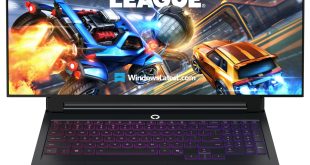Arriving at the plush downtown offices of Hill & Knowlton, one of the world's oldest PR companies, on a chilly October evening – you would have been greeted by the site of a heap of IT journalists squatting, jumping, dancing and laying around big screens playing what appeared to be ‘games from one or two generations ago'. And you would be right. The ‘trick' was what they were competing on. KitGuru operatives snuck in a camera and began secret snapping.
Flying through space, shooting alien saucers. Bouncing up and down like a demented panda. Running across a fixed set of terrain, shooting enemies with ‘blobby energy guns'. It all looks very familiar – like sitting in a Chinese restaurant when they play ‘hits of yesteryear', but not using the original singers. It's a little different, but we're all familiar with the tune and words. The Intel Gaming Pentathlon was not geared around the latest and greatest – but more around ‘Can you have a full on, 5-stage, gaming competition – without a graphic card in site?'.
Intel went one stage further, in that none of the 5 game competitor stations they had set up had a traditional PC anywhere near them.
One was being driven by a new/anonymous mini-gaming console. Another used an Ultrabook, while the station next to it had a HD screen being driven by what looked like a tiny phone.

Intel's message seems clear: Graphics on Ivy Bridge are usable, they provide an engaging experience and ‘you just wait until Haswell gets here in Q2'.
The ‘Haswell' part of the message is important, because Intel graphics have not finished evolving. The experts on hand were keen to point out that things really will get ‘quite tasty' in the new year. We're thinking back to the last days of Pentium 4, when Intel went on a global road trip to discuss benchmarking in the 21st century. At the time, Intel was getting pasted by AMD, so there was a lot of inquisition about Intel's motives for such a tour. Then Conroe arrived, the tour made perfect sense and Intel's desktop team have never looked back. It's extremely unlikely that Haswell will deliver a Conroe-type revolution but, if power consumption can be brought under control, then the future certainly looks more competitive.

Pro-gamers, in the shape of Dignitas, were on hand to show how gaming should look – but the evening was really all about a bunch of technology and gaming journalists having a few beers, eating posh sandwiches and trying damn hard to beat their rival's scores on the 5 games being shown.
On that basis, Intel's messaging worked and made sense. They showed (evil PR geniuses that they are), that you can fill an evening with entertainment – even if what you're looking at on the screen seems more like a first generation Wii game than something you might expect on a £1,500 Ultrabook.
Will this generation of Intel gaming graphics worry nVidia and AMD? Not a chance. The A10 5800k launch demonstrations were stunningly better. We saw side-by-side comparisons, on the latest games, where AMD's integrated solution was around 3x faster than Intel's mainstream graphics offer. But that's not quite what Intel is aiming at.
While AMD and the whole APU/Fusion programme has captured the hearts and minds of the next generation of console manufacturers – and Apple is treading its own unique path to retinal wonder, Intel is looking at markets like Tablets, with a known/trusted partner like Microsoft, and thinking “Can we be, just a little… cool?”

KitGuru says: Fun was being had but, if we're honest, the idea of a £1,500 Ultrabook running a game that looks like Unreal tournament of yesteryear, doesn't make you want it at all – while seeing someone playing HD games with a tiny little phone is actually quite cool. The tablet experience will be the real battleground for Intel, but we're not sure how much impact they can make here until the Broadwell shrink of the Haswell chip in the 2014/2015 time frame, because it's all about power consumption and small power means small chips.
Comment below or in the KitGuru forums.
 KitGuru KitGuru.net – Tech News | Hardware News | Hardware Reviews | IOS | Mobile | Gaming | Graphics Cards
KitGuru KitGuru.net – Tech News | Hardware News | Hardware Reviews | IOS | Mobile | Gaming | Graphics Cards


